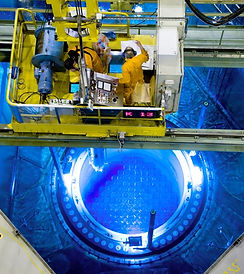

Nuclear Fission
Conventional nuclear fission has helped power our world for more than 70 years. All the while, not releasing any hydrocarbons in the atmosphere.
"Nuclear reactors are, fundamentally, large kettles, which are used to heat water to produce enormous amounts of low-carbon electricity. They come in different sizes and shapes, and can be powered by a variety of different fuels." —World Nuclear Association
Interested in learning more? Take a look at these resources below.
Let's talk science!
How does a reactor make energy?
Step 1: Fission

Fission
Fission is the process in which a heavy atomic nucleus splits into two smaller nuclei, accompanied by the release of a large amount of energy, neutrons, and radiation. This reaction is typically initiated by the absorption of a neutron by a heavy nucleus like uranium-235 or plutonium-239, making the nucleus unstable. Fission is the principle behind nuclear reactors and atomic bombs, and while it produces substantial energy, it also generates long-lived radioactive waste.
Step 2: Heat

How a Nuclear Reactor Works
In a Boiling Water Reactor (BWR) the water flows through a single, primary loop from the reactor core to the turbine. In this system, water in the reactor core comes into contact with the fuel rods. As the water is heated by nuclear fission, it changes to steam. The steam then flows out of the reactor to the turbines. The steam turns the turbines of the generator to produce electricity. At the generator, there is an external system that uses water from the environment (river, ocean, lake, reservoir) to condense the steam in the primary loop back into water. Water in the primary loop is then pumped back into the reactor vessel where the cycle is repeated. Impurities in the water in the primary system can absorb radiation from the reactor and may become radioactive. Water in the external system does not come into contact with the reactor vessel or water in the primary system. Thus, it is not radioactive and can be returned to the environment after use.
The Pressurized Water Reactor (PWR), is the most popular commercial reactor type worldwide. Unlike a BWR, a PWR has primary, secondary, and external heat exchange systems, or loops. In the primary loop, heated water from around the reactor is sent to a steam generator or heat exchanger. (A pressurizer prevents the water in the primary loop from boiling.) Here, thermal energy is transferred from the reactor water in the primary system to a separate secondary system, which includes a water and steam mixture. The water from the primary loop does not physically mix with water and steam in the steam generator. The steam in the secondary system flows into the turbine where it turns the generator and generates electricity. This steam is then condensed by water from the external loop before it returns to the steam generator where it is heated and repeats the cycle.
Step 2: Generating & Cooling

Cooling & Generating
While in the Boiling Water Reactors and Pressurized Water Reactors each have their own unique benefits, they both need to have their primary cooling loop cooled down (or condensed) after going through the primary heat exchanger.
There are many ways to cool reactor loops, but one commonly known way is via cooling towers. Cooling towers are typically confused with smoke stacks, and are a popular identifying characteristic of nuclear power plants. While smoke stacks emit carbon dioxide and other hydrocarbons, nuclear cooling towers are just oversized heat exchangers. As hot water is cooled in the tower, it generates steam, not smoke.
Alternatively, many reactors are cooled via available once-through cooling systems, such as rivers, lakes, or oceans.
